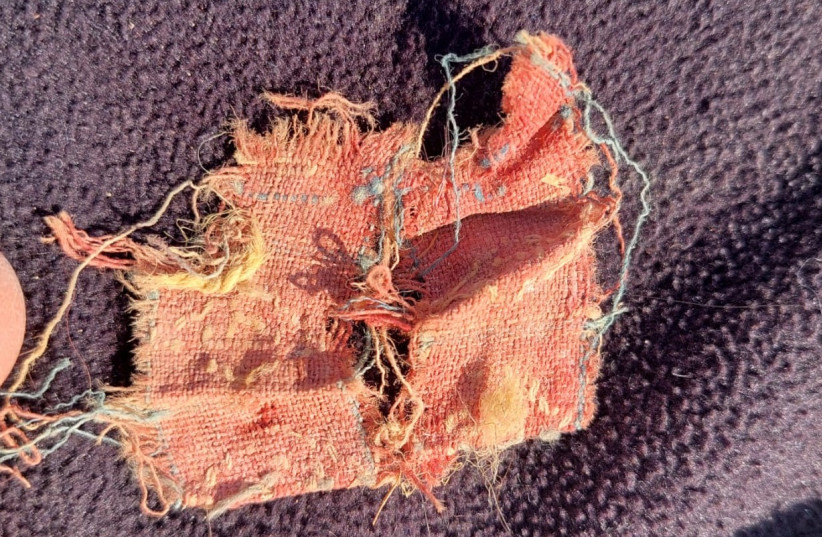Cotton and silk fabrics from about 1,300 years ago found in the Arava are evidence of ancient trade from the Far East, through Israel and Europe, according to archaeologists at the University of Haifa who are leading the excavation.
“Our findings are apparently the first evidence that there was also an ‘Israeli Silk Road’ that passed through the Negev and the Arava and is a new link that was not known until today in the international traderoutes that connected East and West, between Asia and Europe from the main Silk Road,” said Prof. Guy Bar-Oz from the university’s School of Archeology and Maritime.
In an excavation he conducted at the Nahal Omer site in the Arava in collaboration with Dr. Roy Galili from Ben-Gurion
University of the Negev in Beersheba, Dr. Orit Shamir from the Israel Antiquities Authority, Dr. Britt Hildebrandt from Germany’s University of Gottingen and Nofar Shamir from the University of Haifa, the researchers found a wealth of artifacts imported from the East dating from to the early Islamic period.
“Our findings are apparently the first evidence that there was also an ‘Israeli Silk Road’ that passed through the Negev and the Arava and is a new link that was not known until today in the international traderoutes that connected East and West, between Asia and Europe from the main Silk Road."
Prof. Guy Bar-Oz

What was the Silk Road?
The Silk Road was the main overland trade route for the transfer of goods from China, through India, Egypt and the Middle East to Europe. The main routes of the road passed through Constantinople, the capital of the Byzantine Empire, which is today’s Istanbul. “The models of transporting goods and the variety of traded materials testify
to the processes of globalization that the Middle East experienced at the end of the first millennium,” explained Bar-Oz and Galili. The archaeological find, which can be touched with the fingers, was rare."
In this study, the researchers follow the changes that occurred along the timeline through the analysis of garbage accumulations of sites along the roads to learn about the daily life of the leaders of the ancient
caravans and in search of the exotic materials that were transported along the way. During the study, garbage was examined Nahal Omer site in the Arava – a site from the 7th century CE, the beginning of the
Islamic period in the region.
To their surprise, the researchers discovered an organic “cache” that included a wealth of findings depicting in detail the material culture and daily life of the ancient desert dwellers including textiles, clothing items, hygiene items such as cotton swabs to clean the ears and bandages, leather straps, belts, socks, shoe soles, combs and more.
The abundance of organic items that were discovered made it possible to carry out an accurate dating using carbon-14, and they were dated to the 7 th and 8 th centuries CE. “The findings include a large
number of imported materials including textiles with typical decorative patterns originating from India and silk items from China that had not yet been discovered in Israel during this period. The richness and
abundance of the finds indicates the great demand for luxury products from the East,” explained Shamir, a textile expert. The researchers believe that the cotton fabrics probably came from India and Manubia (today’s Sudan) – two major cotton production centers known from the period - and that the silk fabric found is significant evidence of trade originating in China.
Nahal Omer is so far the most important in terms of textile finds of all the ancient sites discovered in Israel. The findings on the site show a leap forward in technological development. Many cotton textiles
were found on the site, some decorated with an Ikat pattern. In this technique the two are tied and dyed before weaving in a pre-prepared pattern. So far, Ikat cotton fabrics – dyed with a technique for creating a
distinct style of pre-weaving textile patterns formed by binding individual yarns or bundles of yarns with a tight wrapping applied in the desired pattern – have been discovered in a small number of sites in the Middle East.
On the other hand, in wall paintings in the Ajanta Caves in India dating to the Sixth Century CE, figures were seen dressed in clothes decorated with patterns similar to those found in Nahal Omer. The fabrics also provide “greetings” from Iran. Also found were textiles made of white cotton and colored wool woven together in a complex weave and used to make carpets and are still produced in a similar way in different regions of Iran and other countries in Central Asia. According to the archaeologists, the colors of the fabrics have been well preserved and they are decorated with a variety of colors and shapes in shades of blue color that comes from indigo, red from the Rubia tinctorum plant, brown and more.
They further added that during the early Islamic period, the historic Spice Route through which goods passed from southern Arabia to the Mediterranean ports during the Hellenistic and Roman periods
was no longer active. Therefore, they estimate that the excavation findings for the first time indicate changes in the nature of the road, its course and the goods that passed through it in the processes of globalization. “The findings from the excavation reflect unique connections on a global scale with textile production sources in the Far East and add new information to the importance of the road in the regional and global aspect for the transfer of goods, people, technologies and ideas,” Bar-Oz concluded.
